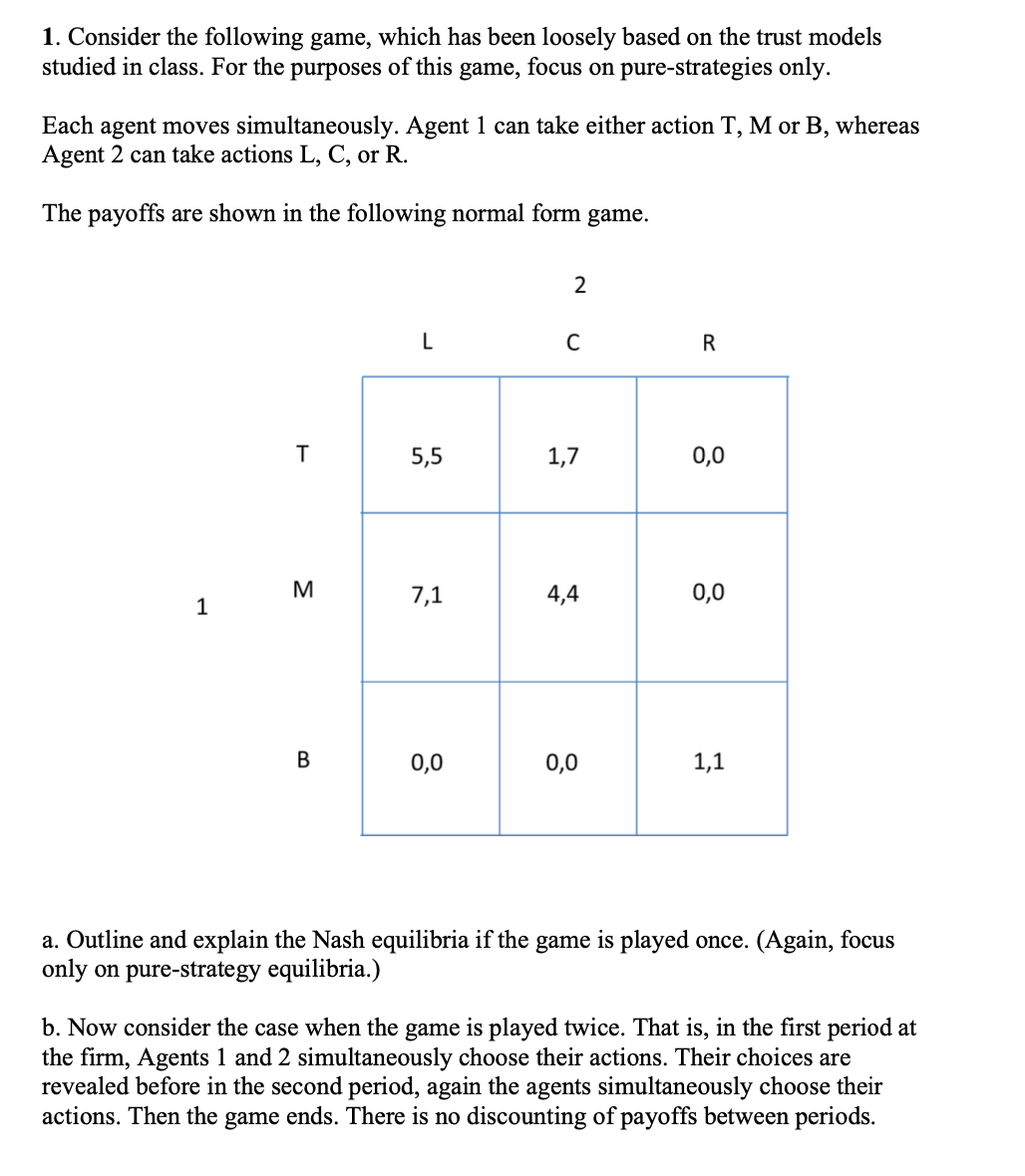1. Consider the following game, which has been loosely based on the trust models studied in class. For the purposes of this game, focus on pure-strategies only. Each agent moves simultaneously. Agent 1 can take either action T, M or B, whereas Agent 2 can take actions L, C, or R. The payoffs are shown in the following normal form game. 2
1. Consider the following game, which has been loosely based on the trust models studied in class. For the purposes of this game, focus on pure-strategies only. Each agent moves simultaneously. Agent 1 can take either action T, M or B, whereas Agent 2 can take actions L, C, or R. The payoffs are shown in the following normal form game. 2
Managerial Economics: A Problem Solving Approach
5th Edition
ISBN:9781337106665
Author:Luke M. Froeb, Brian T. McCann, Michael R. Ward, Mike Shor
Publisher:Luke M. Froeb, Brian T. McCann, Michael R. Ward, Mike Shor
Chapter15: Strategic Games
Section: Chapter Questions
Problem 3MC
Related questions
Question

Transcribed Image Text:1. Consider the following game, which has been loosely based on the trust models
studied in class. For the purposes of this game, focus on pure-strategies only.
Each agent moves simultaneously. Agent 1 can take either action T, M or B, whereas
Agent 2 can take actions L, C, or R.
The payoffs are shown in the following normal form game.
1
T
M
B
L
5,5
7,1
0,0
2
C
1,7
4,4
0,0
R
0,0
0,0
1,1
a. Outline and explain the Nash equilibria if the game is played once. (Again, focus
only on pure-strategy equilibria.)
b. Now consider the case when the game is played twice. That is, in the first period at
the firm, Agents 1 and 2 simultaneously choose their actions. Their choices are
revealed before in the second period, again the agents simultaneously choose their
actions. Then the game ends. There is no discounting of payoffs between periods.

Transcribed Image Text:Outline how, as part of a subgame equilibrium that the threat to play either B or R in
the final period rather than M or C can help sustain the cooperative outcome of (T,L)
in the first period. Interpret this two-period game as a trust game. Explain why 'trust'
(or cooperation) can be achieved in the first period of this game without having to
resort to an infinite-horizon game.
Expert Solution
This question has been solved!
Explore an expertly crafted, step-by-step solution for a thorough understanding of key concepts.
Step by step
Solved in 2 steps

Knowledge Booster
Learn more about
Need a deep-dive on the concept behind this application? Look no further. Learn more about this topic, economics and related others by exploring similar questions and additional content below.Recommended textbooks for you

Managerial Economics: A Problem Solving Approach
Economics
ISBN:
9781337106665
Author:
Luke M. Froeb, Brian T. McCann, Michael R. Ward, Mike Shor
Publisher:
Cengage Learning

Managerial Economics: Applications, Strategies an…
Economics
ISBN:
9781305506381
Author:
James R. McGuigan, R. Charles Moyer, Frederick H.deB. Harris
Publisher:
Cengage Learning


Managerial Economics: A Problem Solving Approach
Economics
ISBN:
9781337106665
Author:
Luke M. Froeb, Brian T. McCann, Michael R. Ward, Mike Shor
Publisher:
Cengage Learning

Managerial Economics: Applications, Strategies an…
Economics
ISBN:
9781305506381
Author:
James R. McGuigan, R. Charles Moyer, Frederick H.deB. Harris
Publisher:
Cengage Learning


Exploring Economics
Economics
ISBN:
9781544336329
Author:
Robert L. Sexton
Publisher:
SAGE Publications, Inc

Microeconomics: Principles & Policy
Economics
ISBN:
9781337794992
Author:
William J. Baumol, Alan S. Blinder, John L. Solow
Publisher:
Cengage Learning